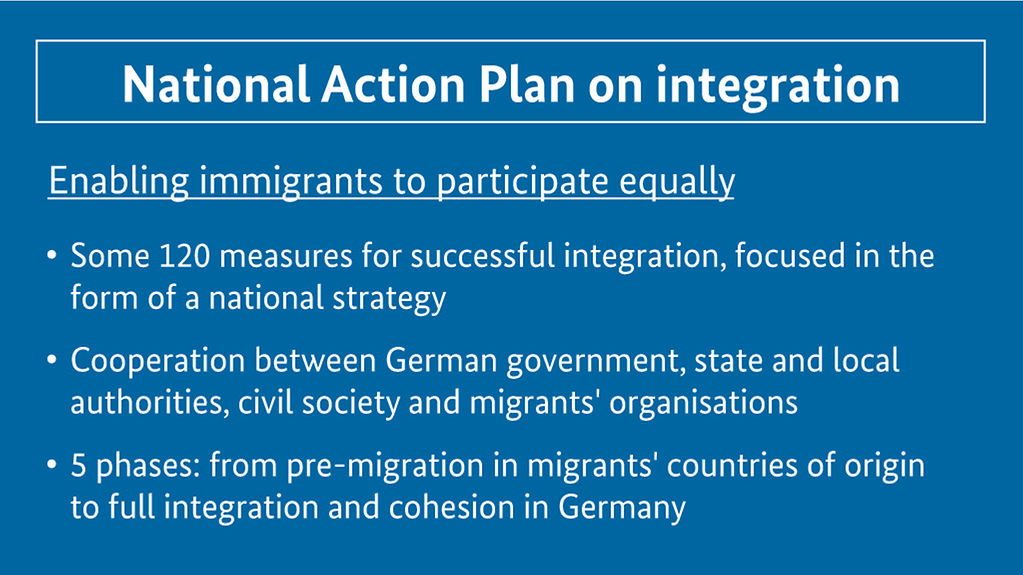FAQs on the National Action Plan
The National Action Plan on Integration ensures that federal, state and local authorities cooperate with one another and with other partners to enable everyone in Germany to contribute to society – helping immigrants find their feet in a new environment, learn German, attend school or find a job. The Cabinet has now adopted explanations laying out how projects are to be further implemented under the National Action Plan. Here are some FAQs.
4 min reading time

The period immediately after their arrival is crucially important for the integration of all new immigrants
The diagram is entitled "National Action Plan on integration", with a subtitle "Enabling immigrants to participate equally":
- Some 120 measures for successful integration, focused in the form of a national strategy
- Cooperation between German government, state and local authorities, civil society and migrants' organisations
- 5 phases: from pre-migration in migrants' countries of origin to full integration and cohesion in Germany
Photo: Bundesregierung
What is the National Action Plan on Integration?
The National Action Plan on Integration (NAP-I) brings together the many and diverse integration measures of the German government in the form of a nationwide strategy. It addresses five phases of immigration and cohabitation:
- Phase I – Before migration: "Managing expectations – providing guidance"
- Phase II – Initial integration: "Facilitating arrival – communicating values"
- Phase III - Integration: "Providing for participation – encouraging and requiring active involvement"
- Phase IV – Growing together: "Managing diversity – ensuring unity "
- Phase V - Cohesion: "Strengthening cohesion – shaping the future "
The German government has never before turned its attention to the entire integration process so comprehensively and systematically as it does here.
What has the German government decided now?
On Wednesday, the Cabinet adopted a federal government statement on Phases II (initial integration) and III (integration). It included results and specific measures within both phases. They are to be presented by Chancellor Angela Merkel at the 12th Integration Summit, which is to be held on 19 October 2020 at the Federal Chancellery.
The Cabinet is to adopt statements for all five phases of the National Action Plan on Integration. The statement on Phase I (before migration) was adopted on 22 January 2020.
What is Phase I of the Action Plan on Integration?
During the first phase, the aim is to manage the expectations of people who have decided to come to Germany before they leave their own country, and to provide them with guidance. In the countries of origin of migrants, the future immigrants are systematically prepared for Germany, with German language courses, and information and education services. You can find more information about Phase I "Managing expectations – providing guidance" here.
What happens during Phase II "Facilitating arrival – communicating values"?
Phase II begins when immigrants arrive in Germany. The period immediately after their arrival is crucially important for the integration of all new immigrants. They need to find their feet in a new environment, learn German, seek guidance and support. Phase II projects provide for language courses, deliver advice on getting professional and academic qualifications recognised, and promote education and training.
What is Phase III " Providing for participation – encouraging and requiring active involvement"?
Phase III of integration demonstrates how important it is to participate in society, but equally what preconditions must be met before this is possible. The groundwork is needed before services can be provided to ensure successful integration. In addition to open access to the labour market, early childhood education and civil society engagement, suitable support services are needed at local level to develop the skills that individuals need if they are to participate fully in society. That puts in place the preconditions for successful integration and participation on the part of people in Germany who have an immigrant background.
Why does the Action Plan on Integration have these different phases anyway?
Integration means growing together – and that is not something that can happen overnight. The National Action Plan on Integration is broken down into various phases for this reason. People’s needs vary at each of the different phases of integration.
Who is involved?
The German government is working with 300 partners on the National Action Plan on Integration (NAP-I), including state and local authorities, the private sector, civil society and 75 migrants’ organisations.
How does the process work?
All phases include four or five topic-specific forums chaired by the federal ministers responsible. Together, they elaborate up to 24 core projects per phase, working with other federal ministries, state and local authorities and civil society partners. All in all, the participants thus develop around 120 specific measures to foster successful integration. The results of the NAP-I process will be presented at the Chancellor’s Integration Summits in 2020 and 2021.
What are the goals of the National Action Plan on Integration?
With the National Action Plan on Integration, the German government is translating into practice the pledge laid out in the coalition agreement, to focus the many and varied integration measures in the form of a nationwide strategy that both supports migrant and expects them to do their bit. The aim is to improve the life situations of people with a migrant background, enable them to participate equally and strengthen cohesion within society. With this goal, a total of 24 topic-specific forums chaired by the federal ministries responsible are elaborating what are termed core projects along with state and local authorities, non-governmental actors and, above all, migrants’ organisations.